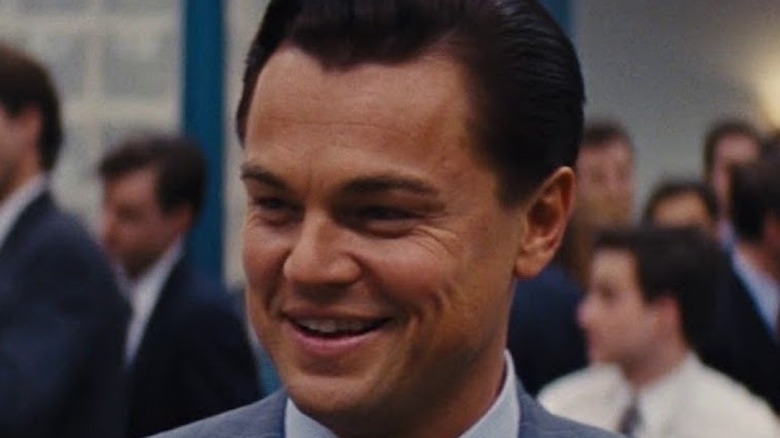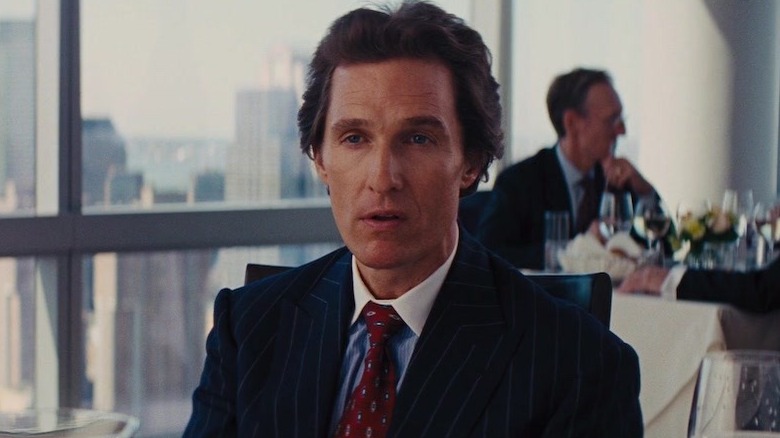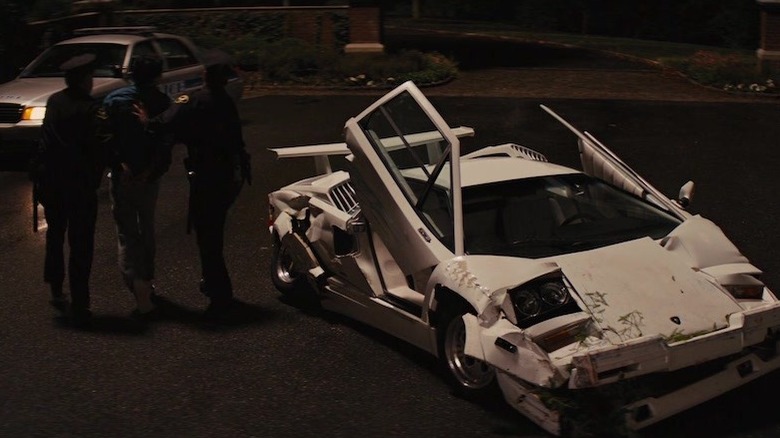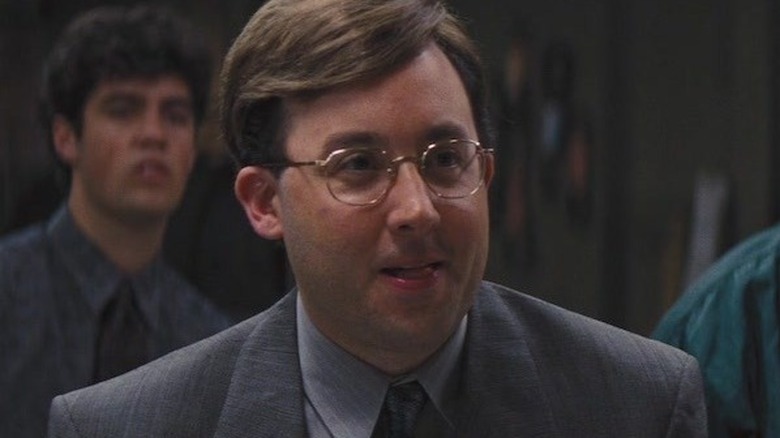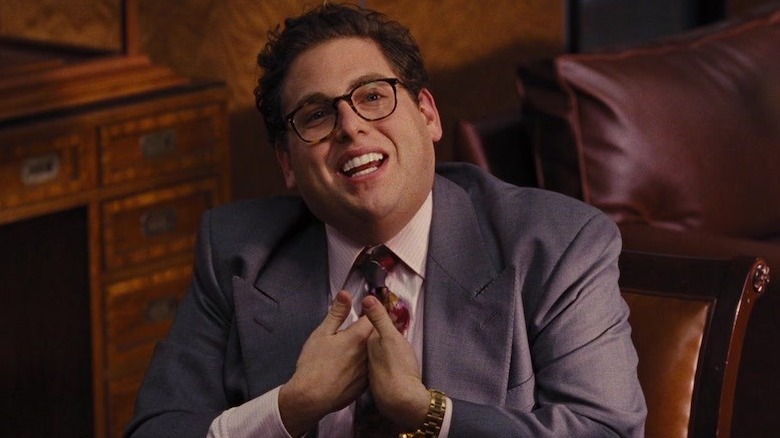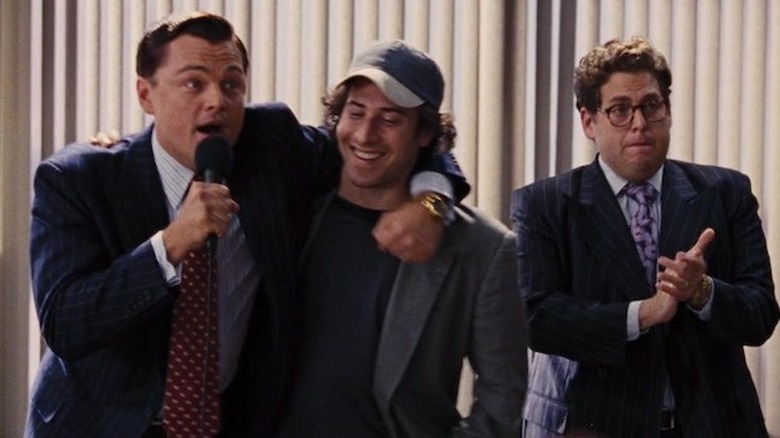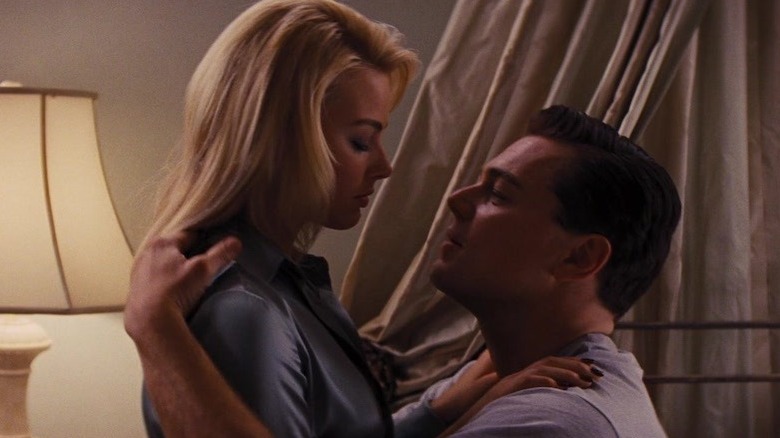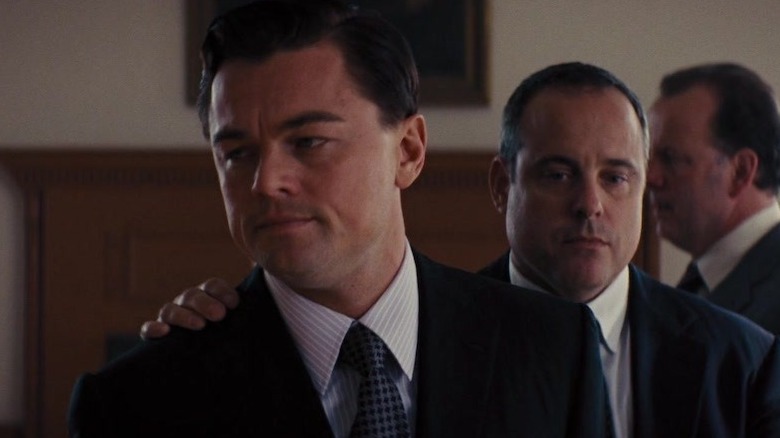How Historically Accurate Is The Movie The Wolf Of Wall Street?
Martin Scorsese's 2013 film "The Wolf of Wall Street" is the answer to the question, "what if Mötley Crüe's life story, but with IPOs, white-collar crime, and even more sex, booze, drugs, and money?" Based on the memoir of the same name by convicted stock fraudster Jordan Belfort, the movie stars Leonardo DiCaprio as Belfort, a brash young stockbroker from the Bronx who goes on to co-found the Stratton Oakmont brokerage house in the late 1980s and make a ton of money while running the firm.
While the name may sound legit, Stratton Oakmont is nothing more than a made-up name with a made-up backstory. And the way they do business is anything but legal — their "pump and dump" scheme involves misleading investors by hyping up no-name companies listed on the pink sheets, which drives up their stock prices and allows Belfort and co. to sell their artificially overvalued shares. This then brings the prices back down to earth, leaving investors with virtually nothing while the folks at Stratton keep getting richer and richer. It's a pretty shady scheme alright, and Belfort got away with it for years.
That, however, merely scratches the surface when talking about a three-hour film with so many seemingly over-the-top moments. "The Wolf of Wall Street" may have been based on a true story, but with DiCaprio's on-screen Belfort serving as a classically unreliable narrator, how much of the film is historically accurate and how much of it is fiction?
Mark Hanna is real, but the chest-thumping scene isn't
Although he played a rather small part in the movie, Matthew McConaughey made quite the impact in "The Wolf of Wall Street." He stole the show in the early goings as Mark Hanna, Jordan Belfort's boss at L.F. Rothschild, which sold its brokerage operations in January 1988, according to The New York Times — it didn't exactly "close its doors" within a month of the October 1987 stock market crash, as Belfort claimed in the film. And in case you're wondering whether Hanna's real or not, we can certainly assure you he is. He even has his own website where he references how McConaughey made him "famous" in "The Wolf of Wall Street."
During the movie's now-iconic restaurant scene, Hanna gives Belfort some advice on how to survive the dog-eat-dog world of Wall Street; per The Daily Beast, the real Hanna did indeed tell Belfort that masturbation, cocaine, and sex workers were his keys to success. But what's the deal with the chest-thumping and chanting scene that has become so beloved among fans? McConaughey explained to Business Standard that this was his own relaxation technique, one he had performed behind the scenes of his previous films. It was added to the restaurant scene at the last moment, and that definitely worked like a charm — it's impossible to talk about Hanna's corruption of the then-newbie stockbroker Belfort without mentioning the chest-thumping.
Many of Belfort's wildest moments did happen in real life
After Jordan Belfort starts Stratton Oakmont, recruits several ne'er-do-well buddies, and somehow transforms these misfits into ruthless stockbrokers, he's off to the races. We see Belfort and his fellow brokers party like rock stars, with their office oftentimes serving as the center of all the bacchanalia — at one point, he even pays an employee $10,000 to have her head shaved. Aside from the reckless drinking, drugging, and spending, there's the reckless operation of vehicles that leads to Belfort crashing his Lamborghini and almost crashing his helicopter. And we shouldn't forget that time Belfort ignored his captain's warnings about "chop" and insisted on sailing his yacht amid a storm, only for the boat to capsize off the coast of Italy.
Crazy as it may sound to the uninitiated, did all of that really happen? The answer is yes, as The Daily Beast covered all those moments and then some in a 2013 article; the FBI agent who arrested Belfort also vouched for the accuracy of his memoir, per The New York Times. However, there were some notable differences. As for the time that Belfort crashed his Lambo while wasted on expired Quaaludes, The Daily Beast wrote that it was actually a Mercedes-Benz. But even more glaring than the choice of another pricey automobile to crash was the omission of how the real Belfort apparently injured someone during that incident and sent them to the hospital.
Several names were changed and some composites were created
While several characters in "The Wolf of Wall Street" were based on real-life people with the same name, not the least of these being Jordan Belfort himself, the film did rename a number of people and create some composite characters. History vs. Hollywood's "Wolf of Wall Street" page shows the main examples in the cast section — Jonah Hill's Donnie Azoff was based on Stratton Oakmont co-founder Danny Porush, Margot Robbie's Naomi Lapaglia was based on Belfort's second wife Nadine Macaluso, and Kyle Chandler's no-nonsense FBI Agent Patrick Denham was based on an agent named Gregory Coleman. Likewise, Brad Bodnick (Jon Bernthal) was inspired by the real Belfort's Quaalude supplier, Todd Garret.
What about the motley crew of misfits who initially made up Stratton's workforce? That's where the composite characters come in, as the likes of Alden "Sea Otter" Kupferberg (Henry Zebrowski), Robbie "Pinhead" Feinberg (Brian Sacca), Chester Ming (Kenneth Choi), and Nicky "Rugrat" Koskoff (PJ Byrne) were mostly inspired by multiple people mentioned by Belfort in his memoir, then given fictional names, according to The Hollywood Reporter.
That was not enough to mollify former Stratton broker Andrew Greene, who, in 2014, sued the film's producers for defamation because Rugrat was supposedly based on him and made to look like a "criminal, drug user, degenerate, depraved and devoid of any morals or ethics," per The Guardian. (Probably didn't help that Rugrat was a frequent butt monkey for Belfort, Azoff, and their fellow Strattonites.) It was only in 2018 when a judge ruled in favor of the producers, stating that they took all the necessary steps to ensure no one was defamed, such as making Koskoff a composite, giving him a fictional name and backstory, and including a disclaimer during the credits.
Did Danny Porush do the things Donnie Azoff did in the film?
Leonardo DiCaprio may have had a lot of epic moments in "The Wolf of Wall Street" as Jordan Belfort, but Jonah Hill also did a wonderful job playing Belfort's co-founder and second-in-command at Stratton Oakmont, Donnie Azoff. While initially quirky and awkward, Azoff soon proves to be Belfort's equal in the debauchery department, and he has no problem confirming the rumors that he married his cousin. This, of course, doesn't faze Belfort one bit. And later on, Azoff punishes a bowtie-wearing employee who was tending to his goldfish on new issue day by taking the fish out of the bowl and swallowing it alive, much to the delight of the rowdy brokers.
Again, we have to ask the $64 million question — did those things happen in real life? Speaking to Mother Jones, Danny Porush, the man who inspired the Azoff character, blasted "The Wolf of Wall Street" — both the book and the film — for being inaccurate, but acknowledged that he really ate a broker's goldfish, albeit for the slightly different reason that he wasn't performing well enough. Meanwhile, Belfort's memoir (via History vs. Hollywood) claimed that Porush's ex-wife Nancy was actually his first cousin, though she made no mention of this in an exclusive New York Post interview; in fact, she said that she and Danny first met as young adults in the early '80s. Similarly, Nancy Porush recalled introducing her then-husband to Belfort, which goes against how in the movie, Azoff approached Belfort at a restaurant after seeing his flashy new Jaguar parked outside.
The Steve Madden deal
If Martin Scorsese's previous film "GoodFellas" had the Lufthansa heist, "The Wolf of Wall Street" had the Steve Madden initial public offering, which is portrayed as the biggest, most important deal in Stratton Oakmont's colorful history. (Once again, that's also why you really shouldn't be cleaning your fishbowl on new issue day, lest your coked-up boss eat the fish for breakfast before firing you on the spot.) As narrated in the movie, Stratton "secretly" controlled 85% of the footwear maker's shares, and during the IPO, Jordan Belfort exhorts his employees to "ram Steve Madden stock down your clients' throats," thereby driving up the price from its initial $4.50 per share to a whopping $18-plus in a few minutes' time. Soon after, Donnie Azoff bursts in, screaming that Stratton made $22 million in just three hours.
While screenwriter Terence Winter made sure to simplify all the Wall Street-speak for the average viewer, something similar did happen in real life (via The New York Times). And it's also true that Steve Madden himself, upon realizing that the FBI was hot on Belfort's trail, started unloading his shares while still early, as noted by History vs. Hollywood. But what we don't see in the movie is how Madden (Jake Hoffman) also got charged as an accomplice to Belfort. Likewise, his substance abuse issues during the film's timeline weren't documented. He did eventually serve two-and-a-half years of a 41-month sentence for stock fraud.
Belfort's relationship with his second wife was abusive toward the end
Arguably, the most disturbing moment in "The Wolf of Wall Street" comes when Belfort, stressed out because he has to work with the feds and rat out his co-conspirators, asks his wife Naomi to make love to him. She begrudgingly agrees, then announces that she's filing for divorce and that she wants custody of their kids. This enrages Jordan, who breaks a long period of sobriety by snorting his emergency cocaine, then gets verbally and physically abusive toward Naomi. Next, he grabs their young daughter and, while trying to drive away, crashes his car through the garage door, ramming a nearby pillar outside his mansion.
Per History vs. Hollywood, the abuse may have been worse in real life; Jordan Belfort wrote in his autobiography that he kicked his wife Nadine, causing her to fall down the stairs and land with "tremendous force." The incident where he tried to flee with his daughter also happened, per Belfort's memoir, and it appears that he put her through even greater risks, as the girl apparently wasn't wearing a seatbelt. In the film, Belfort made sure that his daughter was buckled up.
If you or someone you know is dealing with domestic abuse, you can call the National Domestic Violence Hotline at 1−800−799−7233. You can also find more information, resources, and support at their website.
The fall of Jordan Belfort
After Stratton Oakmont enjoys its first big successes, we see Kyle Chandler's Agent Denham start working zealously on bringing Belfort and his cohorts to justice. And while he remains stoic till the end, the subway scene says it all — you try to do the right thing, but you're still a nobody compared to the man you've been chasing for years, who essentially gets a slap on the wrist for his crimes. The chickens had come home to roost, as "Mad Max" Belfort (Rob Reiner) once warned his son, and for cooperating with the feds, all Jordan gets is a reduced sentence of three years at a minimum-security federal prison. (Per The Daily Beast, he only served 22 months of what was supposed to be a four-year sentence.)
In an interview with CNBC (via YouTube), Denham's real-life equivalent, Gregory Coleman, explained his motivations for pursuing Belfort and Stratton so doggedly, and they matched up pretty well with what drove the incorruptible Denham in the film. "It was the flashiness, the brashness of their activities, the blatantness of the way they were soliciting people and cold calling people, and the number of victims that were complaining on a daily basis," he told the news outlet.
And yes, you would be correct if you thought that just like in "The Wolf of Wall Street," the real Jordan Belfort now makes an honest living as a motivational speaker. Now sell me this pen.
